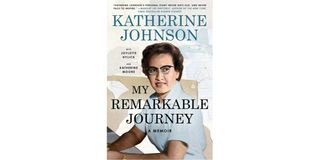Katherine Johnson, the genius behind success of space travels

Katherine Johnson's memoir.
What you need to know:
- She was born on August 26, 1918, at a time when women were barred from voting and black people were treated deplorably as a subordinate race.
- Katherine was a brilliant mathematician with meticulous attention to detail, exceptional leadership skills and a distinctive cachet.
In 1941, Franklin D. Roosevelt, the US president then, signed Executive Order 8802, prohibiting discrimination in federal agencies, including in the defence industry.
The order enhanced fairness in employment for black women, including Katherine Johnson, whose application as a research mathematician was endorsed in 1953.
Katherine was a brilliant mathematician with meticulous attention to detail, exceptional leadership skills and a distinctive cachet. Her calculations on orbital trajectories were seminal to the success of US space-flights.
She was a researcher at the National Aeronautics and Space Administration (NASA) and its predecessor, National Advisory Committee for Aeronautics (NACA), from 1953 to 1986.
During America’s initial orbit around the earth by astronaut John Glenn on February 20, 1962, she was the human computer who double-checked the maths miscalculated by an IBM computing system.
She further computed the flight path that sent Neil Armstrong and the Apollo 11 crew to the moon and back for the first time in history, on July 20, 1969.
Katherine was born on August 26, 1918, in the resort city of White Sulphur Springs, Virginia, at a time when women were barred from voting and black people were treated deplorably as a subordinate race. Overconfidence could easily earn a black person a lynching. Mobs terrorised and randomly executed black communities throughout the US.
At 10, she joined high school. She attended West Virginia Collegiate institute, 122 miles from her parent's home. It was the only school past the eighth grade that educated blacks in the area. She graduated from high school in 1933, during the Great Depression.
Katherine’s memoir, My Remarkable Journey, portrays an inquisitive arithmetician, widowed at 38, when her husband, Jimmie Goble, succumbed to brain tumour. Her brilliance surpassed regular scholarly excellence and her algebra and geometry fascination from infancy, led to a compulsive perfectionist mentality and an obsession with counting.
At 15 when she was in sixth-grade, Katherine was awarded a full-tuition scholarship to study at West Virginia State University. She took a prescient class on Analytic Geometry of Space, before graduating with degrees in mathematics and French in May 1937.
She received another scholarship to advance her studies at West Virginia University (different from West Virginia State). She was the first black graduate student at West Virginia University and the first black female student.
She dropped out of her studies when she was pregnant and delivered her first-born, Joy, in 1940. She gave birth to Constance in 1943 and Kathy in 1944.
“I became a working mother, juggling the demanding responsibilities of motherhood. An exhausting balance I would have to figure out for many years to come,” she writes.
In 1950, in a moment to savour, NACA sent the US Congress a proposal to double its staff from 7,000 by 1953. Katherine applied. In June 1953 at 34, her NACA application was approved, offering twice as much pay as her previous teaching salary.
She was hired as an SP-3, level 3 sub-professional, the entry-level status of most women hired at the agency, regardless of their superior academic qualifications in relation to men’s.
She was assigned to the West Area Computing Unit, a section of 75 exceptionally bright black female mathematicians.
They were called human computers and were responsible for tedious painstaking mathematical calculations relished by engineers and scientists throughout the agency. In that era, only 34 per cent of women in the US worked outside their homes.
After six weeks, Katherine was awarded a promotional permanent position from SP-3 to SP-5 and a salary increment. She was placed in the Manoeuvre Loads Branch, which was responsible for researching aircraft safety.
Among her monotonous and strenuous duties was to review photographic film, from crashed aircraft’s flight data recorders (black boxes).
She plotted data, such as the plane’s airspeed, acceleration, and altitude throughout a flight, on large sheets. She discovered that once a large aircraft passes through an airspace, the troubled air swirled dangerously behind it for as long as half an hour. Her research helped change the rules of the airways.
Due to her research, new rules were implemented to ensure minimum distances between planes flying from east to west and north to south, to prevent future aircraft accidents.
Jeff Anthony is a novelist, a Big Brother Africa 2 Kenyan representative and founder of Jeff's Fitness Centre @jeffbigbrother





